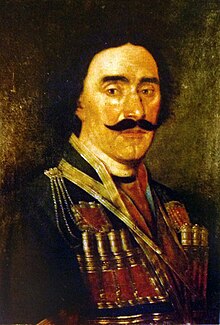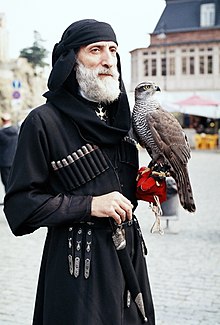
Quick Facts

Biography
The Chokha (Georgian: ჩოხა, ტალავარი, chokha, t'alavari; Abkhaz: акәымжәы, akʷymzhʷy; Adyghe: цые, tsiya; Persian: چوغا, Czugha; Armenian: չոխա, chokha; Azerbaijani: çuxa; Chechen: чокхиб, chokhib; Kabardian: цей, tsei; Lezgian: чуха, chukha; Ossetian: цухъхъа, cuqqa; Russian: черкеска, cherkeska) is a wool coat with a high neck that is part of the traditional male dress of the peoples of the Caucasus.
History and Revival of Chokha


It has been in wide use among Georgians from the 9th century until the 1920s, The trend of Chokha in Georgians still continue to occur as they see it as their proud cultural heritage they inherit till this day. France may be known for its berets, and Spain for its mantillas, but few national costumes are linked to as strong a sense of national pride as Georgia’s Chokhas. Nearly every Georgian household has photos of ancestors adorned in chokhas. Once a symbol of resistance to Bolshevik Russia’s 1921 takeover of an independent Georgia, the chokha has now come to represent a Georgia reborn, a country that revels in its cultural individuality. Increasingly worn by Georgian men at weddings and official functions, the eye-catching garb is finally experiencing a comeback in Georgia. The Chokha revival is taking place in parallel with a resurgence of interest in other mainstays of Georgian culture – the Georgian Orthodox Church, Georgian folk dancing, and choral singing. “When you love your Chokha, you love your country. When you love your country, you love your traditions! The Chokha emphasizes I am a Georgian. It is a spiritual costume!” a leader of the All-Georgia Chokha Society said. The Chokha is truly a strong representation of Georgian national pride. Worn by Georgians for more than a thousand years, the high-necked wool coat was rarely seen during Soviet rule, but now again, for many it symbolizes the country's proud past and resistance to its occupation.
Georgian President Mikheil Saakashvili ordered high-ranking Georgian officials working abroad to present themselves in national costumes at the official meetings. So, in the very center of Europe, in the 21st century, among the elegant ladies and gentlemen classic suits, one will be surprised to find strangely dressed men in their Chokhas, and daggers around the waist.
Types of Chokha


There are Four types of Chokha: Kartl-Kakheti chokha (Kartli and Kakheti are eastern Georgian provinces), Khevsur Chokha (mainly in Mtskheta-mtianeti province of Georgia), Adjarian chokha (mainly found in western Georgia provinces such as Adjara and Guria and also used to be used in Lazona that is now part of republic of Turkey, it is shown in fourth picture on this page) and General Caucasian chokha which most likely to Kartl-Kakheti chokha and is little longer version of it.
Caucasian Chokha originated in Caucasus in mountainous sites of Georgia, though the word "Chokha" isn't in Georgian language but from Persian. Originally the cloth in Georgia was referred as Talavari but later on after Persian invasions in Georgia, Persians called Georgian national dress Chokha (meaning fabricly made outfit). The name of the cloth mostly known as "chokha", the Russians who came to the Caucasus through Circassia called it "Cherkeska" (meaning Circassian dress), and the Cossacks adopted it as their national cloth. In Circassian Language Chokha is known as "Shwakh-Tsia"" which means "covers the horseman" or simply "Tsia" which means "from fabric" and "Fasha" which means "Fits you". The authentic Caucasian Chokha became instantly popular in entire Caucasus, it derived from caucasus and has been commonly used in Southern and Northern slopes of it. In earlier Georgian records Chokha was mostly referred as Talavari.
In Georgia, the Black chokha was reserved to the "Order of Chokhosani" who represented the elite society of the citizens. These were people with special dedications such as: Great generals, heroes or some of the famous poets and the people who had done some big service to the country. Not even all of Lords were allowed in "Chokhosani Order" and those who did proudly represented this rank in their Garbs. Chokha is sewn of thick fabric and flares out at the bottom. In some parts of the Caucasus there are also female chokhas.
In the late 19th century and early 20th century there were three types of chokhas: the Khevsur chokha, the Kartl-Kakheti chokha and general Caucasian chokha.
Khevsuruli Chokha

The Khevsur chokha was worn in the Khevsureti province of Georgia in the Greater Caucasus mountains. Khevsur chokha is considered to be the closest to the medieval version of chokha. It is mostly short with trapezoid shapes. The front side of the chokha has rich decorations and cuts on the sides, which extend to the waist. The Khevsur chokha has rich decorations made up of crosses and icons.
Kartl-Kakheti Chokha

The Kartl-Kakheti chokha is longer than the Khevsur chokha and has triangle-like shapes on the chest exposing the inner cloth called arkhalukhi. It tends to have bandoliers on both sides of the chest, spaces filled with bullet-like decorations called Masri. The bottom sides usually had cuts on the sides and people wore it usually without belts. The Kartli-Kakheti chokha has long sleeves and mostly is black, dark red and blue.
General Caucasian Chokha

The general Caucasian chokha shares similarities with the Kartl-Kakheti version. In most cases different decorations are used to fill the bullet spaces. In the Russian language, chokha is called cherkeska and this type of chokha has black leather belts decorated with silver pieces. It was usually a longer version of Kartl-kakheti Chokha.
The general Caucasian chokha is mostly made of black, grey, white, blue, red or brown fabric. Among Azeris, it is considered part of the traditional outfit for the performers of mugham, an Azeri folk music genre. A person's age defined the colour of the chokha he would wear.
Generally, the chokha outfit includes a khanjali (the sword), the akhalukhi (a shirt worn underneath the chokha), the masrebi (the bullets), and the kabalakhi (a hood, separate from the robe) or nabdis kudi (a tall fur hat).
